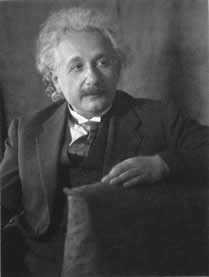Albert Einstein (1879)

Source: Ulmann, Wikimedia Commons (Public Domain)
Albert Einstein was born in Germany in 1879. He enjoyed classical music and played the violin. One story Einstein liked to tell about his childhood was of a wonder he saw when he was four or five years old: a magnetic compass. The needle's invariable northward swing, guided by an invisible force, profoundly impressed the child. The compass convinced him that there had to be "something behind things, something deeply hidden."
Even as a small boy Einstein was self-sufficient and thoughtful. According to family legend he was a slow talker, pausing to consider what he would say. His sister remembered the concentration and perseverance with which he would build houses of cards.
In
1933, he joined the staff of the newly created Institute for Advanced Study
in Princeton, New Jersey. He accepted this position for life, living there until
his death. Einstein is probably familiar to most people for his mathematical
equation about the nature of energy,  .
.
Einstein wrote a paper with a new understanding of the structure of light. He argued that light can act as though it consists of discrete, independent particles of energy, in some ways like the particles of a gas. A few years before, Max Planck's work had contained the first suggestion of a discreteness in energy, but Einstein went far beyond this. His revolutionary proposal seemed to contradict the universally accepted theory that light consists of smoothly oscillating electromagnetic waves. But Einstein showed that light quanta, as he called the particles of energy, could help to explain phenomena being studied by experimental physicists. For example, he made clear how light ejects electrons from metals.
There was a well-known kinetic energy theory that explained heat as an effect of the ceaseless motion of atoms; Einstein proposed a way to put the theory to a new and crucial experimental test. If tiny but visible particles were suspended in a liquid, he said, the irregular bombardment by the liquid's invisible atoms should cause the suspended particles to carry out a random jittering dance. One should be able to observe this through a microscope, and if the predicted motion were not seen, the whole kinetic theory would be in grave danger. But just such a random dance of microscopic particles had long since been observed. Now the motion was explained in detail. Einstein had reinforced the kinetic theory, and he had created a powerful new tool for studying the movement of atoms.


